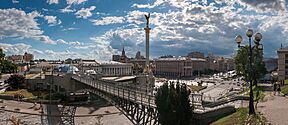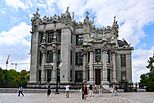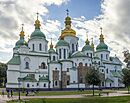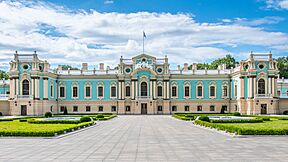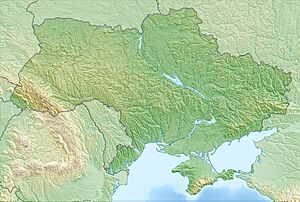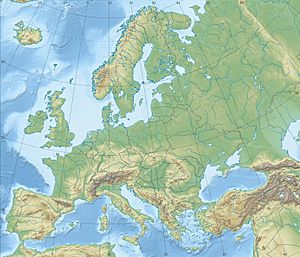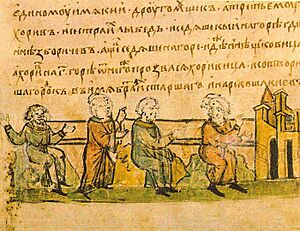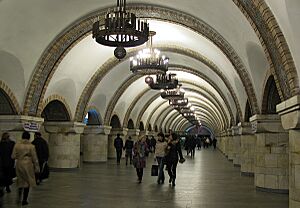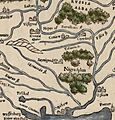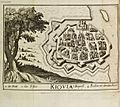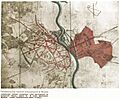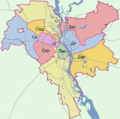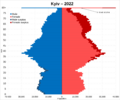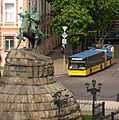Kyiv facts for kids
Quick facts for kids
Kyiv
Київ
Kiev
|
|||||
|---|---|---|---|---|---|
|
Capital city and city
with special status |
|||||
|
Kyiv Pechersk Lavra
Red University Building
House with Chimaeras
Mariinskyi Palace
|
|||||
|
|||||
| Nickname(s):
Mother of Rus' Cities
|
|||||
| Anthem: How Can I Not Love You, Kyiv of Mine! |
|||||
| Country | Ukraine | ||||
| Municipality | Kyiv | ||||
| Founded | AD/CE (officially) 1494 (Magdeburg rights) |
||||
| Named for | Kyi | ||||
| City council | Kyiv City Council | ||||
| Districts |
List of 10
Darnytskyi District
Desnianskyi District Dniprovskyi District Holosiivskyi District Obolonskyi District Pecherskyi District Podilskyi District Shevchenkivskyi District Solomianskyi District Sviatoshynskyi District |
||||
| Area | |||||
| • Capital city and city with special status |
839 km2 (324 sq mi) | ||||
| Elevation | 179 m (587 ft) | ||||
| Population
(1 January 2021)
|
|||||
| • Capital city and city with special status |
|||||
| • Rank | 1st in Ukraine 7th in Europe |
||||
| • Density | 3,299/km2 (8,540/sq mi) | ||||
| • Metro | 3,475,000 of the Kyiv metropolitan area | ||||
| Demonym(s) | Kyivan, Kievan Киянин, Киянка (uk) |
||||
| GDP | |||||
| • Capital city and city with special status | ₴1.28 trillion (US$46.76 billion) (2021) | ||||
| • Per capita | ₴431,616 (US$15,815.9) (2021) | ||||
| Time zone | UTC+02:00 (EET) | ||||
| • Summer (DST) | UTC+03:00 (EEST) | ||||
| Postal code |
01xxx–04xxx
|
||||
| Area code(s) | +380 44 | ||||
| ISO 3166 code | UA-30 | ||||
| Vehicle registration plate | AA, KA (before 2004: КА, КВ, КЕ, КН, КІ, KT) | ||||
| FIPS code | UP12 | ||||
| NUTS statistical regions of Ukraine | UA63 | ||||
Kyiv (also spelled Kiev) is the capital city of Ukraine. It is the largest city in the country and one of the oldest cities in Eastern Europe. Kyiv is located in the north-central part of Ukraine along the Dnieper River.
The city is a major center for culture, science, and industry. It has many universities, high-tech companies, and famous historical landmarks. Kyiv also has a large public transport system, including the Kyiv Metro, which is a subway system with some of the deepest stations in the world.
As of 2022, nearly 3 million people lived in Kyiv, making it the seventh-most populous city in Europe.
Contents
Name of the City
The name Kyiv comes from the Ukrainian language. The name Kiev comes from the Russian language.
According to an old legend, the city was named after Kyi, the oldest of three brothers who founded the city.
Today, "Kyiv" is the official spelling used by the government and most international organizations. Many people started using "Kyiv" instead of "Kiev" to show support for Ukraine's independence and its own language.
History
Legends and Early Days
People have lived in the area around Kyiv for thousands of years, dating back to the Stone Age.
There is a famous legend about how the city began. It says that three brothers named Kyi, Shchek, and Khoryv, along with their sister Lybid, built the city. They named it Kyiv after the eldest brother.
Historians believe the city started as a trading center around the 5th or 6th century. It was located on a major trade route that connected Scandinavia (where the Vikings lived) to the Greek city of Constantinople.
The Golden Age
In the late 9th century, the city became the capital of a powerful state called Kievan Rus'. This was the first state of the East Slavs. During this time, Kyiv was one of the largest and most important cities in the world. It was a center for trade and the Eastern Orthodox Church.
Hard Times and Rebuilding
In 1240, the Mongols invaded and destroyed much of the city. For a long time after that, Kyiv lost its power. Over the next few centuries, it was ruled by different neighbors, including Lithuania, Poland, and Russia.
In the 19th century, while part of the Russian Empire, Kyiv began to grow again. The Industrial Revolution brought factories, railways, and trade. It became an important city once more.
Modern Kyiv
In the 20th century, Kyiv faced many challenges. It suffered during World War I and the Russian Civil War. In 1934, it became the capital of Soviet Ukraine.
During World War II, the city was occupied by Nazi Germany and suffered great damage. A very tragic event happened at Babi Yar, where thousands of people were killed. After the war, the city was rebuilt and grew quickly.
In 1991, the Soviet Union collapsed, and Ukraine became an independent country with Kyiv as its capital.
In February 2022, Russian forces tried to capture the city. The Ukrainian army defended Kyiv successfully, and the invading forces were pushed back.
Geography and Weather
The River and Hills
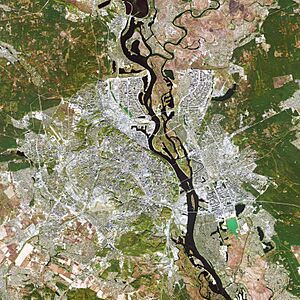
Kyiv is built on both sides of the Dnieper River, which flows south to the Black Sea.
- The Right Bank (western side) is older and has many hills, ravines, and small rivers. This is where the historic center is.
- The Left Bank (eastern side) is flatter and was built up more recently, mostly in the 20th century.
The city has many islands in the river and plenty of water. There are also many parks and forests, making Kyiv a very green city.
Climate
Kyiv has a humid continental climate. This means it has four distinct seasons:
- Summer: Warm and sunny. Temperatures are usually around 25 °C (77 °F).
- Winter: Cold and snowy. Temperatures often drop below freezing. The snow usually stays on the ground from November to March.
How the City is Run
Kyiv has a special status in Ukraine. It is not just a city but also acts like a region.
- The Mayor is elected by the people. The current mayor is Vitali Klitschko, a former world champion boxer.
- The city is divided into 10 districts (called raions). Seven are on the Right Bank and three are on the Left Bank.
People and Culture
Population
Kyiv is home to nearly 3 million people. Most of the residents are ethnic Ukrainians. There are also people from many other backgrounds, including Russians, Belarusians, and Jews.
Language
The official language is Ukrainian. Many people also speak Russian. It is common to hear both languages spoken in the streets, and many people are bilingual (speak two languages).
Religion
Religion is an important part of the city's history. Kyiv is a major center for Eastern Orthodox Christianity. It has many beautiful churches and monasteries with golden domes.
Famous Places to See
Kyiv is full of history and beautiful architecture.
Historic Buildings
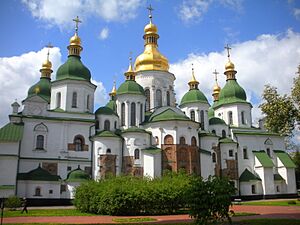
- Saint Sophia Cathedral: Built in the 11th century, it is famous for its mosaics and frescoes. It is a UNESCO World Heritage Site.
- Kyiv Pechersk Lavra (Monastery of the Caves): An ancient monastery founded in 1051. It has a system of underground caves where monks used to live.
- Golden Gate: A reconstruction of the ancient entrance to the city.
- Mother Ukraine: A giant statue made of titanium that stands on a hill overlooking the river. It is part of a museum about World War II.
Museums and Parks
- National Museum of the History of Ukraine in the Second World War: A large complex with open-air displays of military equipment.
- Kyiv Zoo: A large zoo that is home to over 2,000 animals.
- Hydropark: An island in the Dnieper River with beaches, boat rentals, and amusement parks.
Getting Around
Kyiv has a large public transport network.
- Kyiv Metro: The subway system is very popular. It is fast and has beautiful stations that look like underground palaces. The station Arsenalna is the deepest metro station in the world, going 105.5 meters underground!
- Trolleybuses and Trams: Electric buses and trams run throughout the city.
- Funicular: A cable railway that connects the historic upper town with the lower commercial district called Podil.
Sports
Football (soccer) is the most popular sport in Kyiv. The most famous team is FC Dynamo Kyiv. They have won many championships and play in a large stadium called the Olimpiyskiy National Sports Complex. This stadium hosted the final match of the UEFA Euro 2012 championship.
Images for kids
-
Hungarians at Kyiv in ancient times
-
Bohdan Khmelnytsky entering Kyiv
-
Ruins of Kyiv during World War II
-
Concert on Maidan Nezalezhnosti
-
Monument to Vladimir the Great
-
Antonov An-124 Ruslan aircraft
-
Pianist Vladimir Horowitz
-
Actress Milla Jovovich
-
Aviation pioneer Igor Sikorsky
-
Politician Golda Meir
See also
 In Spanish: Kiev para niños
In Spanish: Kiev para niños


